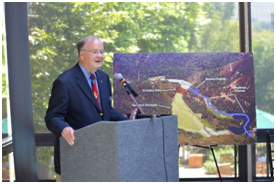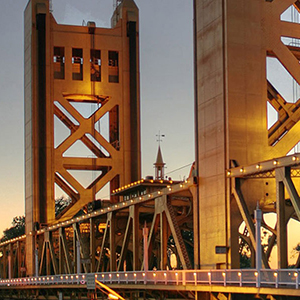Last week, elected officials, conservation groups and community leaders from across the state gathered in Carmel for a groundbreaking celebration to tear down San Clemente Dam. The event, hosted by California American Water (CAW), in partnership with the California State Coastal Conservancy, NOAA Fisheries and The Nature Conservancy, included state and federal representatives as well as leadership from nonprofit organizations who contributed to the dam removal effort.
“This project will be the largest dam removal in state history,” said Representative Sam Farr. “It marks the beginning of a new era for this river, its inhabitance and the community it benefits. The project itself also marks a new way forward in terms of public-private partnerships and working together to accomplish major infrastructure endeavors like this one. This model could be applied to other dams in the state that have exceeded their useful life.”
California Senator Bill Monning commented, “After years of hard work, it’s an honor to join the project team and other dignitaries to celebrate the removal of the antiquated San Clemente Dam and restoration of the Carmel River Watershed.”
The San Clemente Dam, built in 1921, has affected people and nature along the Carmel River. As a result, once vibrant steelhead runs have dramatically decreased and the lives and property below the dam are threatened with the possible collapse of the seismically unsafe structure.
The antiquated dam does not provide significant water storage for the community and given the state’s requirement that the dam to be seismically safe, it presents more of a risk than a benefit. The reservoir is more than 95 percent full with more than 2.5 million cubic yards of sediment and a remaining water storage capacity of only about 70 acre-feet.
The dam removal project was made possible by a strong partnership between CAW, the owners and operators of the dam, the California State Coastal Conservancy and NOAA’s National Marine Fisheries Service. The estimated project construction cost is $83 million. Forty-nine million dollars will be provided by the company and $34 million will come from the State Coastal Conservancy and NOAA Fisheries. The conservancy will raise its portion of the funding from various public and private sources, including a $1-million contribution from The Nature Conservancy.
“Our approach to the dam removal eliminates the cost and environmental impact of transporting the sediment to a different location, while also avoiding increased flood risk for downstream property owners,” said Walter Lynch, President and Chief Operating Officer for Regulated Operations of American Water Works Company, Inc.
The removal project includes an innovative engineering approach of rerouting the river around accumulated sediment.





